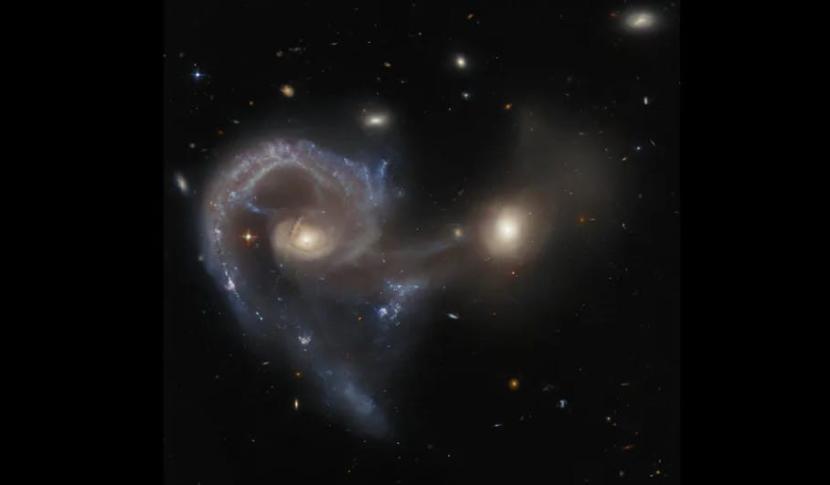Ⓒ Copyright of the photo above is returned to the photo owner
Hubble captured the unusual collision of two galaxies, codenamed Arp 107.
JAKARTA — The Hubble Space Telescope succeeded in observing a very interesting space phenomenon. On September 18, 2023, Hubble captured the collision of two unusual galaxies, codenamed Arp 107.
Quoted from the page Live Science, Monday (2/10/2023), Arp 107 shows a spiral galaxy nicknamed Seyfert, which is connected to smaller galaxies by bridges of dust and gas. It is located 465 million light years from Earth in the constellation Leo Minor.
Why is this so special? Because, Hubble’s capture shows the cosmic collision of two very different types of galaxies. The large galaxy on the left shows spiral arms curving outward from its core, with glowing dust and gas throughout.
Meanwhile, the much smaller galaxy on the right looks like nothing more than a bright nucleus. There is something connecting these two strange-looking galaxies, namely a faintly visible bridge of dust and gas.
As already mentioned, the larger galaxy is the Seyfert galaxy. The spiral galaxy has an active galactic core like a very bright point and is powered by a supermassive black hole. About one in 10 galaxies in the universe are Seyfert galaxies.
These interacting and merging galaxies (including Arp 107) were first cataloged by the American astronomer Halton Arp. The naming was also adapted to Arp. In 1966, he published Atlas of Peculiar Galaxies.
In recent years, Hubble has used advanced survey cameras to make observations of these galaxies. Some of the images captured include Arp-Madore 417-391 and the spectacular triplet galaxy Arp 248.
Can you see it with the naked eye in the night sky? Unfortunately not, because these galaxies are very difficult to see, even when Leo Minor is high in the Northern Hemisphere sky in spring. This view can only be seen with a qualified telescope.
To do this, point the telescope at M51, or better known as the Whirlpool galaxy. Found between Alkaid at the edge of the Big Dipper and the star Cor Caroli in the constellation Canes Venatici, the Whirlpool consists of one large spiral galaxy interacting with a dwarf galaxy right next to it. It’s 27 million light years from the Milky Way, but it’s a bright sight and easy to see, even with a small telescope.
Source: Republic
2023-10-02 20:04:00
#Masha #Allah #Hubble #Telescope #Successfully #Recorded #Galaxy #Collisions #Heres


